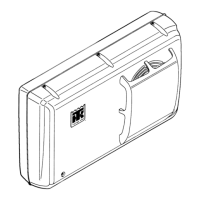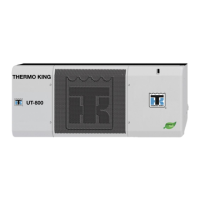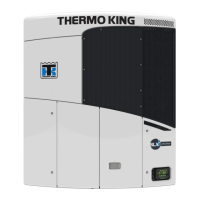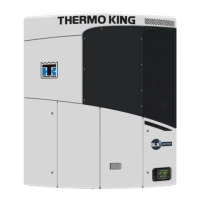Refrigeration Maintenance and Service Operations
149
Installation
1. Clean the tubes for soldering.
2. Place the new valve in position. and solder the
connections.
3. Check for refrigerant leaks (see “Refrigerant
Leak Test Procedure” in this chapter).
• High pressure cutout switch: Pressurize
the high side with refrigerant and check
for leaks.
• Low pressure cutout switch: Pressurize the
low side with refrigerant and check for
leaks. If no leaks are found, recover the
leak test gas (see “Refrigerant Recovery”
in this chapter).
4. If no leaks are found, recover the refrigerant
used for the leak test (see “Refrigerant
Recovery” in this chapter).
5. Evacuate the system (see “Evacuation and
Cleanup of the Refrigeration System” in this
chapter).
6. Reconnect the electrical wires to the switch.
7. Recharge the unit with R-404A (see
“Refrigerant Charge” this chapter).
8. Perform a controller pre-trip test to verify
system operation.
Compressor Discharge
Temperature Sensor or High
Pressure Cutout Switch
NOTE: Replacement procedure when high
pressure cutout switch is located in compressor
discharge manifold.
Removal
1. Front seat the compressor suction service
valve and discharge service valve.
2. Purge the high pressure from the compressor
head through the service port on the discharge
line.
3. Disconnect the leads from the wire harness
and remove the defective switch or sensor
from the compressor discharge manifold.
Warm Gas Bypass Valve, Liquid
Injection Valve or
Coil/Dehumidify Valve
Replacement
NOTE: In most cases, only the coil requires
replacement. No other repair is possible on
solenoid valves.
Removal
1. Recover the refrigerant charge from the unit
(see “Refrigerant Recovery” in this chapter).
2. Turn the U
NIT ON/OFF switch OFF.
Disconnect electrical connections to valve
coil.
3. Coil/dehumidify valve: Remove insulating
tape from liquid line.
4. Unsolder the liquid line connections to the
valve.
5. Remove the valve from the unit.
Installation
1. Clean the tubes for soldering.
2. Place the new valve in position and solder the
liquid line connections.
3. Pressurize the low side with refrigerant and
check for leaks (see “Refrigerant Leak Test
Procedure” in this chapter).
4. If no leaks are found, recover the refrigerant
used for the leak test (see “Refrigerant
Recovery” in this chapter).
5. Evacuate the system (see “Evacuation and
Cleanup of the Refrigeration System” in this
chapter).
CAUTION: Use a heat sink or wrap the
switch with wet rags to prevent damage to
the new switch.
CAUTION: Any time the discharge valve
is front seated, disconnect the unit power
source to prevent accidental compressor
startup.
CAUTION: Use a heat sink or wrap the
switch with wet rags to prevent damage to
the new switch.
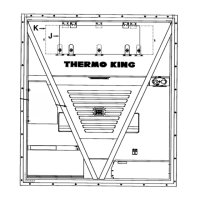
